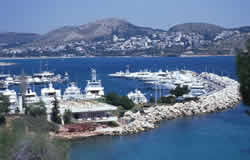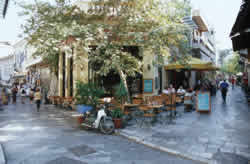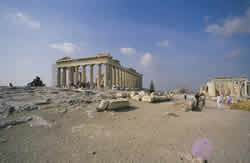|
Learn about Athens, Greece, by reading ancient
Athens by Gary W. Bloom, WTA Member and Leisure
Traveler/Writer. It features a mini, but thorough tour of
the destination, plus all you'll need to know to plan your
trip including how to get there, objective information on
places to stay and eat, and things to do. At the end of
the article, we've provided a summary of the contact
information for your easy reference. Enjoy!
Ancient Athens
by
Gary W. Bloom, WTA Member and Traveler/Writer

Along with ancient ruins, Athens
also showcases beautiful harbors The
modest hotel room had one outstanding luxury. From its window was
a commanding view of the Acropolis. This is not unusual. The
Acropolis can be seen from just about anywhere in Athens. Even in
the polluted air, the Acropolis gleamed honey white in the stark
Athenian sun. Walking around Athens, it was a constant reminder of
the city's brilliant past.
But
Athens is much more than the Acropolis. The Greeks' greatest art,
it has been said, is that of living. Their love of beauty can be
seen everywhere. To experience this art you must wander through
the streets of the Agora and Plaka sections of Athens.
The
Plaka is situated on the north side of the Acropolis. This area,
reminiscent of the way all of Athens once was, contains
traditional taverns, churches, and residences. There have been
residents here since prehistoric times. In the tavern you can
sample the relatively inexpensive mazes - appetizers consisting of
olives, cheese, tomatoes, dried fish, and octopus. You can also
drink the national libation, ouzo, an aniseed flavored liquor.
More adventurous types might try Knockouts, lamb heart and liver
wrapped in intestines and roasted over a grill. Many of the shops
close at 2 p.m., when workers go home for lunch and a siesta. They
open at about 4 p.m., when customers again fill the cafes, sipping
Retina, a wine flavored with resin, and twirling "worry
beads."

A cafe in The Pl aka of
Athens
The
Agora, or marketplace, is northeast of the Acropolis. This was the
commercial center of ancient Athens. The chariots of the
Anathema Festival passed through the Agora on their way from
the Diploma Gate, the ancient entrance to Athens, to the
Acropolis. The raised circular floor of the Thomas, the seat of
ancient Athens government, can be seen here. Nearby, free meals
for life were given to any winner of the Olympic games. The Stoat
of At talus, reconstructed in the 1950's and consisting of 134
columns, is also in the Agora. Socrates and the other great
philosophers of the day held their discussions here.
Walking through the Agora and continuing in a northeast direction,
I entered the Ceramics Cemetery. One of the oldest cemeteries in
the world, settlers around the Acropolis buried their dead here
beginning in the 11th century BC. Near the entrance to the
cemetery on Hermes Street is a museum that contains many of the
more recent finds from the cemetery, including an extensive
collection of pottery. The cemetery was named after Kearns, the
patron of potters. Many of the tombs are embellished with carved
representations of the dead. Some tombs have statues of the
deceased, standing or sitting on horseback. The Athenians often
placed vases on the tombs. The bottoms of these vases had holes
drilled in them so wine could be poured in and received by the
dead.
In
the southeast corner of the cemetery is the Diploma Gate, the
largest in Athens. This was the main entrance into the ancient
city. The gate was heavily used by travelers coming into and out
of the city, and was a productive location for prostitutes to
greet weary travelers.
Walking
through the Diploma Gate and back through the Agora, as the
ancient travelers had, the Acropolis can first be seen. Acropolis,
which means simply "upper town," was a fortress and a
sacred sanctuary of the goddess Athena. Upon seeing it, I could
well imagine the ancient Greeks' belief in the mythological gods.
It is truly one of the wonders of the world; an awe inspiring feat
of architecture and art.
Walking
past the Prophylaxes, the entrance to the Acropolis, I looked down
at the worn rock and saw the imprints of chariot wheels from
ancient times. Passing through the gates, I was met with the
beautiful western view of the Parthenon. The Parthenon took nine
years to complete and was dedicated to the virgin goddess Athena.
The columns were constructed with Enteric marble that with age
has turned a mellow honey color. Built in 450 BC, it is 228 feet
long and 101 feet wide. There are no straight lines in its
construction. The columns have a slightly inward curve that is not
only visually pleasing but an enormous feat of mathematical
precision. Like the tombs of Egypt, scientists are still astounded
that such a structure could be built in ancient times.
Like
the Greeks themselves, the Acropolis has weathered difficult
times. It has been used as a Turkish harem, a brothel and as an
ammunition dump for Turkish soldiers. Through it all it has
remained a shining symbol of democracy and art.
The
Acropolis Museum is located at the south east corner of the
Acropolis. Many of the ancient sculptures from the Acropolis are
housed here, protected from the elements. Near the museum is the
Theatre of Dionysus, named after Dionysus, the god of drunkenness,
ecstasy, transformation, and the mask. When first built, there
were 64 tiers and a capacity of 17,000 spectators. A marble wall
surrounds the stage, providing protection from wild animals that
were included in the shows during Roman times. The theatre was the
stage for the first tragedy plays and is considered the birthplace
of European theatre.

The Acropolis
There
are, as one would expect, many excellent museums in Athens. The
National Museum is at the top of the list, containing the largest
collection of Greek art and more masterpieces of ancient art than
any other museum in the world. There are countless treasures,
including the gold funerary mask recovered in Mycenae, believed to
be from about 1580 B.C.
Athens
is to this day an archaeological dig in progress. Archaeology,
incidentally, comes from the Greek word "arcade." A new
subway system under construction in Athens has unearthed Roman
baths, a Byzantine mosaic, and other treasures. So many treasures,
in fact, that the subway's main stations will each have museums
displaying some of the treasures found at that site.
The
Greek word for stranger, "xenon", is also the Greek word
for guest. The people were always courteous and friendly. The
British poet Shelley wrote, "We are all Greeks. Our laws, our
literature, our religion, our arts..." A trip to Athens is,
in many ways, a homecoming.
Details
Getting there:
The Athens International Airport, Deleterious Venezuelans, recently
opened. It is located in Sparta, 30km east of Athens (Phone:
011-30-1-353-0000; Fax: 011-30-1-353-2284.) Carriers flying
nonstop from the US to Athens include Delta and Olympic Airways,
Greece’s national airline, with many others offering connecting
service. Round-trip airfares could be found for under $600 from
the US to Athens for travel during summer 2001.
Where to stay:
-
Grande Restage Hotel (Sheraton)
Vas. Georgia St.
Constitution Square
Athens 10563
Phone: 011-30-1-333-0000 or1-888-625-5144
(US only)
Email:
info@HotelGrandeBretagne-ath.gr
The Sheraton Grande Restage, an Athens landmark, counts
among its guest list some of the most prominent
politicians and actors of the twentieth century. During World War II it was the headquarters for each
succeeding power - the Greeks, Germans, and the British.
It’s in an enviable location, near the House of
Parliament and the National Gardens. Many of the rooms
have views of the Acropolis. Doubles are about $211.
-
Acropolis View Hotel
Roberto Gallia & Webster 10
Athens 11742
Phone: 011-30-1-921-7303
Many of the rooms in this hotel, as the name suggests,
have a view of the Acropolis. Doubles range from around
59 Euro (about $52) during the winter to 81 Euro (about
$71) during the summer.
-
Acropolis House Hotel
Od os Odor 6-8
Athens 10558
Phone: 011-30-1-322-2344
Small hotel on the edge of Pl aka. A favorite of visiting
students and teachers, with doubles starting around
D15,000 (about $39).
Where and What to eat:
While a gourmand might not travel to Athens just for the
food, there are a number of interesting dishes, such as
octopus and squid stewed in wine, fried cuttlefish, and
roast lamb. The national aperitif is Ouzo, an aniseed
flavored liquor.
-
Victoria
Navaho Apostolic 7, Pirie
Athens
Phone: 011-30-1-321-1200
Greek food prepared in surprising ways, this restaurant
has a variety of interesting dishes like pork tenderloin
in Retina and rabbit croquettes. Dinners are around
$40.
-
Variously
14 Deliver Street, Piraeus
Athens
Phone: 011-30-1-411-2043
One of the best seafood restaurants in Athens, Variously
is famous for their monkfish. Dinners are about D15,000 (about $39).
When to go:
Athens has a Mediterranean climate of warm days and mild nights,
though in the winter the temperature can dip into the 40’s. The
main tourist season is in July and August, when the crowds and the
heat are their most stifling. Prices, as in most of Europe, are
best in the winter, early spring, and late fall.
Getting around Athens:
Most of the sites are in a small central area, so reaching them by
foot is usually not a problem. Athens has a bus and trolley
system, but they are extremely crowded during rush hour. Taxis are
relatively inexpensive, but they do have a reputation of
overcharging tourists. Ask the hotel concierge what the fare to
your destination should be before getting a taxi. If the driver
charges a fare that is too outrageous, threatening to call the
police usually brings it down considerably.
Dollar value:
The Drachma is the unit of currency in Greece, with an exchange
rate as of May 2001 of 1 US Dollar to 387 Greek Drachmas. With the
favorable exchange rate (just a few years ago, 1 US Dollar was
worth only about 240 Drachmas) Athens is a relatively inexpensive
destination.
Attractions:
-
Acropolis and Acropolis Museum
Dionysian Repaint
Phone: 011-30-1-321-4172
From November 1st to March 31: Open Daily 8:30am-3pm.
From July 1st to October 31: Monday - Noon-7pm Tuesday -
Sunday and holidays 8am-7pm. The entrance fee is D2,000
(about $5.17) for both the museum and archaeological
site.
-
Ceramics Cemetery
148 Armour St
Phone: 011-30-1-346-3552
Open Tuesday to Sunday from 8am to 3pm. The entrance fee
is D500 (about $1.30).
-
National Archaeological Museum
Parisian 44 St
Phone: 011-30-1-821-7717
Summer hours - Monday: 12.30-7pm, Tuesday- Sunday:
08am-7pm. Winter hours - Monday:
10:30am-5pm, Tuesday- Sunday: 8.30am-3pm.
Admission - D2,000 (about $5.17).
More Information:
-
Greek National Tourism Organization -
http://www.gnto.gr/
Olympic Tower - 645 Fifth Avenue
New York NY 10022
Phone: (212) 421-5777
168 North Michigan Avenue / Suite 600
Chicago Illinois 60601
Phone: (312) 782-1084
611 West Sixth Street / Suite 2198
Los Angeles California 92668
Phone: (213) 626-6696
-
Hellenic Ministry of Culture - https://www.culture.gov.gr/en/SitePages/default.aspx
Notice: This information is current as of
May 2001. It is recommended that you contact the numbers, and/or
visit the web sites above to determine any changes to the
information.
|